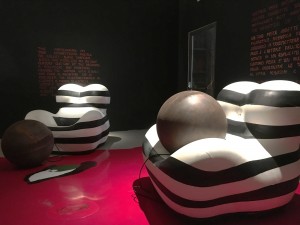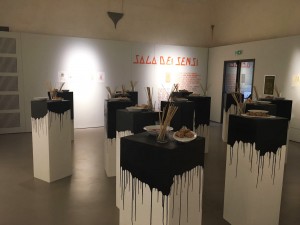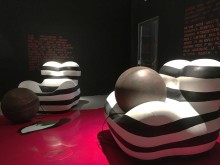
Museo del Novecento
21 ottobre 2016 – 7 febbraio 2017
Di Tania Mio Bertolo ed Elena Zinanni (Università degli Studi di Firenze)
Cos’è la “Maestà Tradita”?
È la donna umiliata, mortificata e sottomessa dai suoi stessi figli. È il trionfo del femmineo.
È quella scultura dalle tinte rosee e dalle forme morbide e tondeggianti che campeggia da qualche mese in Piazza Santa Maria Novella a Firenze. Si tratta di fatto di un’installazione site-specific pensata e realizzata dall’artista Gaetano Pesce, e che trova naturale compimento nella mostra allestita presso il vicino Museo del Novecento. Qui una porta in vetro scorrevole rivestita ai lati da panni stracci, e sopra la quale campeggia a caratteri cubitali il titolo della mostra ci conduce all’interno dell’esposizione. Un ingresso non sobrio, trionfale ed avvilente allo stesso tempo. Ed è proprio sull’equilibrio instabile di questa ed altre contraddizioni che si regge l’intera mostra: dal suo significato intrinseco, al suo allestimento, al titolo stesso.
Gaetano Pesce emerge nella scena artistica internazionale come designer, noto soprattutto per la Serie Up: sette modelli di poltrone delle quali la più celebre è la UP5. Modellata sulle morbide forme delle paleolitiche icone divine della fertilità, la UP5 è oggigiorno uno dei simboli del design italiano ed è presente in diversi musei internazionali. La Maestà Tradita in Piazza Santa Maria Novella e la Libertà Tradita esposta nella sala principale della mostra nascono proprio come evoluzione e delle forme e dei significati simbolici dell’unione delle UP5 e UP6 (il poggiapiedi).
L’allestimento della mostra si sviluppa in tre sale, delle quali una, l’ambiente più grande, funge da fulcro principale e le altre due da corollario, funzionali a spiegare per immagini e parole le fasi di progettazione e i modelli artistici che hanno ispirato la grande installazione, nonché a veicolare ulteriormente le stratificazioni del messaggio che l’artista ha voluto trasmettere. L’arte contemporanea, sempre più frequentemente criptica ed autoreferenziale, non mi è mai apparsa tanto chiara ed esaustiva. L’artista ed i curatori sono riusciti attraverso le molteplici vie che l’arte offre ad esplicitare il messaggio. E difatti l’allestimento della mostra è un felice connubio delle discipline artistiche: pittura, scultura, disegno, architettura, poesia. Un’esplosione di colori, materiali e tecniche artistiche usati con genialità e sensibilità per creare un allestimento in cui ogni elemento è di forte impatto sia scenico che simbolico. Il visitatore, catapultato in una quinta teatrale nella quale solo le uscite d’emergenza mantengono un legame con la realtà, è al contempo spettatore ed attore: come attore egli può sedersi nelle UP5 e sentire l’odore delle “fatiche femminili”, come spettatore può leggere le scritte sulle pareti e comprendere a pieno il significato della mostra.
Intendo insistere su quest’ultimo punto. Spesso le esposizioni di arte contemporanea peccano di poca empatia e chiarezza. Nel caso di questa mostra, invece, il messaggio è limpido ed arriva al visitatore con immediatezza ed originalità. Le utili didascalie ed i filmati esplicativi sono qui sostituiti da colorati graffiti sui muri ed interessanti disegni progettuali, oltre che da oggetti artistici di carattere ludico ed interattivo. Ed anche l’installazione in Piazza Santa Maria Novella, scultura che benchè si dichiari site-specific apparentemente sembra non avere nessun legame con il luogo in cui è collocata, trova comprensione attraverso la lettura della targhetta posta nel piedistallo: un omaggio alle maestranze artistiche attive nella Firenze medioevale, come d’altronde sono anche le opere in mostra nella Cappella interna del percorso espositivo.
Il cerchio si chiude e i nodi contraddittori insiti nella mostra si sciolgono per diventare rappresentazione a tutto tondo dell’arte e della condizione umana, contraddittoria per natura.

Museo del Novecento
October 21, 2016 – February 7, 2017
Translated by Rachyl Grussing (Istituto Lorenzo de’ Medici)
What is the “Majesty Betrayed”?
She is a woman humiliated, mortified and subdued by her own children. She is a triumph of the feminine.
It is the sculpture of rosy hues with soft and rounded shapes that will stand for some months in the Santa Maria Novella square in Florence. It was made and designed as a site specific installation by Gaetano Pesce, and it naturally finds fulfillment in the exhibition at the nearby Twentieth Century Museum. Here, sliding glass doors lined on the sides with cloth rags, and on top of which stands, in large letters, the title of the exhibition, leading into the exhibition. An understated entrance, triumphant and daunting at the same time. And it is an unstable balance of this and other contradictions that hold the entire show, from the intrinsic meaning, to the construction, to the title itself.
Gaetano Pesce emerged into the international art scene as a designer, best known for his Up Series: seven armchair models of which the most famous is UP5. Modeled on the soft forms of the Paleolithic divine fertility icons, UP5 is one of the symbols of Italian design and is present in diverse international museums. The Majesty Betrayed in Santa Maria Novella Square and the Liberty Betrayed displayed in the main hall of the exhibition are born of evolution, like the forms and meanings of symbolic union between UP5 and UP6 (the footrest).
The exhibition is divided into three rooms, one of which, the larger environment, serves as the main hub for the other two by corollary, functional words and images explain the stages of design and artistic models that inspired the exhibition, as well as to further convey the stratification of the message that artist wanted to convey. Contemporary art, increasingly cryptic and self-referential, has never seemed so clear and exhaustive. The artist and the curators have managed, through many ways, to create art that spells out the message. And, in fact, the layout of the exhibition is a happy blend of artistic disciplines: painting, sculpture, architecture, poetry. The explosion of color, materials, and artistic techniques used with genius and sensitivity to create a setting in which each element has both a strong scenic and symbolic impact. The visitor, catapulted into a theatrical setting, in which the emergency exit signs are the only link with reality, is both spectator and actor: as an actor he can sit in UP5 and smell of ‘female labor’, and as a spectator he can read the writing on the wall, to fully understand the significance of the exhibition.
I intend to insist on the last point. Often contemporary exhibitions are guilty of little empathy and clarity. In the case of this exhibition, however, the message is clear and gets to the visitor with immediacy and originality. Useful captioning and explanatory films are here replaced by colorful graffiti on the walls and interestingly designed drawings, as well as artistic objects of fun and interactive character. Also, the installation in Santa Maria Novella, declared to be a site-specific sculpture, it apparently has no connection with the place in which it is located, and is only understood through reading the tag placed on the pedestal: a tribute to active artistic works in medieval Florence, as indeed are the works on display in the inner Chapel of the exhibition.
The circle closes and contradictory knots inherent in the exhibition melt to become a well-rounded representation of art and the human nature, contradictory by nature.
